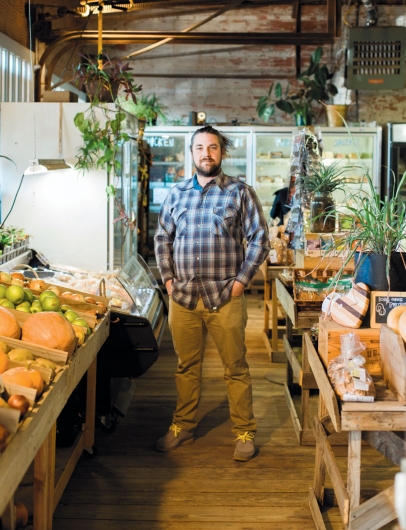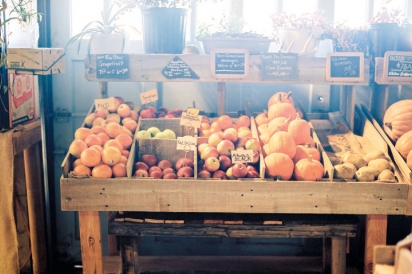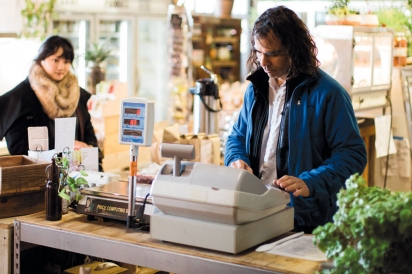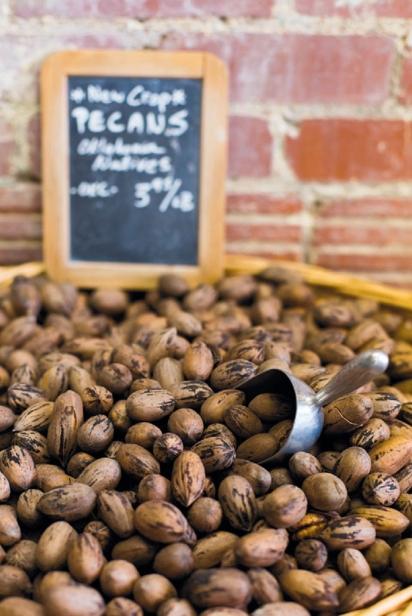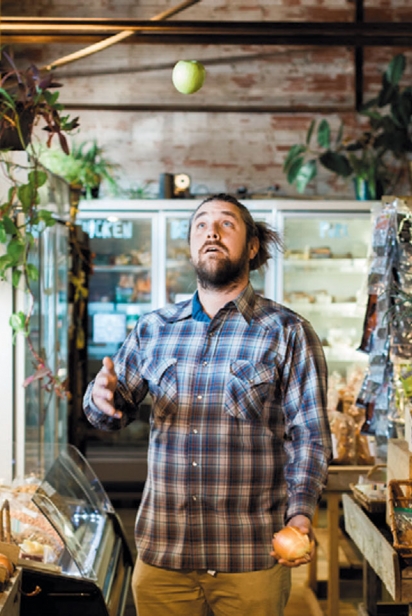Urban Agrarian
Man for the Land
Why did you start Urban Agrarian?
I worked on farms and in the local food scene in Georgia and, when I moved back to Oklahoma, I realized there wasn’t a similar scene here. I couldn’t name one farm back then. In short order, I found out about the statewide food co-op and met some growers, but the co-op only distributed one day a month. So, there was room for a lot more to happen. The term “middle man” isn’t looked kindly upon, but I saw that efficient distribution was missing from the industry and decided to focus on it. In Georgia, I’d also found out that diesel trucks could run on waste vegetable oil. That was the start of what is now the Veggie Van.
That truck’s been good to you!
It’s the best $5,000 I ever spent. It generated a lot of public interest in the beginning, too, because it ran on waste vegetable oil from area restaurants. Now we have four trucks and are working on brewing biodiesel. There’s a lot to learn—and a lot of red tape to get through—before you can make your own fuel. But that’s a long-term goal.
How have things changed in the last 8 years?
When I started, it was me rolling around Oklahoma trying to find people growing things. I bought whatever existed without knowing what would sell. Now, we talk with the growers before the growing seasons start about what we see plenty of, what we sell out of, and what we could use. Being able to give that feedback and work with them on what they grow is a definite shift.
Also, we didn’t have a brick and mortar store when we started. Our goal to provide access to local foods is still the same, but now there’s the added component of revitalizing the Farmers Market District, which historically was used for that purpose. This area used to be a bustling place full of growers and vendors before it became a quiet and almost-dilapidated part of town. Now there’s growing support for a district built around local foods, and a lot of construction and new businesses popping up here.
So, you’re not on an urban island anymore.
Exactly. And the story makes sense: trying to revitalize the district at the same time as the rest of urbanization in Oklahoma City occurs. To see it happening in this district where we are is really fulfilling. If we can stay down here, recruit other businesses, and improve the aesthetics of the area—it would be amazing. We’ll surround and bring back the original Farmers Market. Bud Scott, an attorney and local food advocate has put together the Farmers Market District Association. Anthem Brewery, Urban Farmhouse Designs, Urban Agrarian, and Powerhouse are all involved, but there are other folks like Loomis Automotive, Goodwill Industries, and Ozarka. The district is bigger than just the Farmers Market. We had our first fundraiser in January and are looking at long-term funding. The Plaza District, for instance, was the result of a years-long process.
How does UA impact farmers’ livelihoods?
The business model for local farms is to grow a few acres of assorted produce, pick it right before the weekend, haul it into town, sell it at the market, and bring the rest back. There’s always excess and, if the growers have a little time, maybe they hustle to try and sell it to restaurants. That’s a difficult model to sustain. You’re asking the person who grows the food to recreate the entire market chain: production, sales, marketing, accounting—it’s tough. And, because it’s not an efficient model, most farms must have an off-farm income. We help growers concentrate on production and planning production by offering pick-up, market knowledge, and by selling it in town—consolidating the process. And, we can offer chefs food from 20-30 producers, making it easy for the restaurants to support local food without having to maintain 20-30 relationships.
It sounds like pretty rewarding work.
Yes, definitely. I love taking products directly from farms and then sending the farmers money for it. There are farms that get a big chunk of their annual income from us, so knowing that we help make a farm viable is important to me. We live in an energy-rich and energy-dependent economy that sometimes forgets to diversify. Most of the people I went to high school with work in the energy sector. That’s fine, but when you get together with each other, you realize that’s what everyone is doing. Having a diverse economy is necessary to its health, and agriculture and food production should be a large part of that. I think whatever you can grow in an area, you should.
Talk to me about the value in eating seasonally.
When you eat something in season, you’re eating the best version of that thing. You’re having it in the time that it’s meant for. When you eat something out of season, it’s not going to be as good and probably will have been grown far away and picked under-ripe. There’s a window of time that makes a Bartlett pear or a Brandywine tomato or a fresh blueberry so much of a treat. It’s like little holidays all throughout the year: a blueberry holiday and a peach holiday, a sweet corn holiday and an apple holiday. There are always things to look forward to.
Are there products/produce you can’t get here in OK, but wish you could?
Kumquats! I want some kumquats so badly. I am hoping I’ll find a bunch in Texas, which has some great citrus. We do bring in some regional foods and are interested in looking around the region for things we can’t find here. We also don’t have much pasture-based meat, due to a lack of processors. If we could have kumquats and more processors to process free-range meat, it would improve our local food scene a lot.
How is the Earth Elements Entrepreneur’s Kitchen, housed in your building, improving the local food scene?
The kitchen was April Harrington’s concept. She’d been working on canning and preservation with her business, Earth Elements, and saw that other small-scale food producers needed a kitchen space. It’s a 1,500 square-foot kitchen, so—big enough to handle her production and large enough for others to use the space as an incubator. That’s where Della Terra Pasta, Backyard Bounty Bakery, Healthy Cravings, Towhead Salsa, Waving Wheat Bakery, and others got started. It gives people a low-cost option to get their food business started.
Where is UA headed?
We will have a legitimate grocery store in the Farmers Market District in the next few years. We will build out a large space and will include more regional stuff along with all of our current produce and offerings. We’ll also create more routes that go out to more farms, increasing our deliveries and offerings here in town. This means more farms will be viable because of their ability to sell year-round and, hopefully, means that more restaurants will use local foods. We’d like to benefit ten to fifteen farms on one route with one truck per day. We’ll also pursue more catering with seasonal menus—something we’ve been doing over the last year. That shows people more directly what food we have access to and what can be done with it.
I’m excited to see the food truck park which is being built near us, The Loaded Bowl coming down, Power House doing great—I’m really excited about this area. We’re on the outskirts of the redevelopment with the park and core to shore so I’m really looking forward to see what we can get done over the next few years. When we came in there was very little left. Now these spaces are being filled up with ambitious and dynamic concepts.


